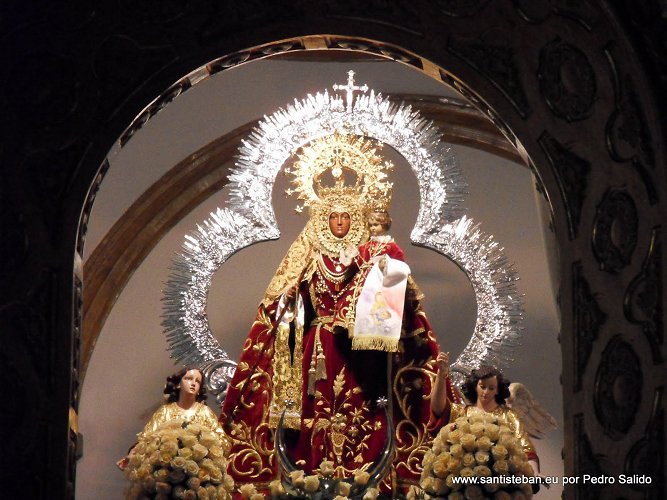Santisteban del Puerto
Photo: Pedro Salido
Our Lady of Collado
Patron of Santisteban del Puerto
In the province Jaén of Andalusia, in the church Santisteban del Puerto on the Plaza Mayor, copy of ancient statue that was lost. Wood.
This is one of those interesting Black Madonnas with white Baby Jesus, the Yin and Yang of popular Catholicism, if you will. For more details and other examples see Foggia paintings, San Severo, and Chipiona.
Legend recounts that this statue was found by a farm worker called Esteban Solís Palomares on April 26th 1232. It was only six years after the Muslim occupation of the area ended and the local farmers dared to expand their territories, tilling soil that had long lain fallow. That day his team of mules all of a sudden had a hard time continuing in their path. He beat them onward until, with great effort, they unearthed a big church bell. When he cleaned it up a bit, he found that a beautiful Madonna and Child were hidden inside. Full of emotion, not only he but also the mules fell on their knees and stayed there a long while absorbed in adoration. This was the first miracle the Black Madonna worked in that town.
Once Esteban composed himself again, he picked the image up, and leaving behind the mules yoked to the plow, headed for the village. Some people who saw what was going on, followed him, and so the first of many procession of the Virgin began.
Esteban headed straight to the village council with his precious cargo and told his story. With great solemnity it was decided to place the Madonna in the Chapter House where she was adored by all who heard about the event. That same day the village council and clergy held a public meeting at which it was agreed to call the image Virgin of Collado, after the site where she was found, to build her a hermitage in that same place, and to make her the patroness of their town.
During the construction of her first hermitage Our Lady was placed in an old Romanesque church at the foot of the castle. The following year the town took a solemn vow to hold festivals every year in honor of the Black Madonna on Pentecost, the day of the coming of the Holy Spirit. They continue to this day.
For some reason a certain Don Amador Chércoles Colomo published a booklet in 1886, in which he claimed that the Madonna was found in 1532. Yet many documents prove that the discovery took place many years before. E.g. the confraternity of Our Lady of Collado was founded in 1502. It too continues to this day and lists more historical facts on its website.
The Black Madonna of Santisteban holds a stick that symbolizes her rule over her town. Baby Jesus holds the world in his left hand and blesses it with his right.
Santisteban church
Her Romanesque church was either built on top of an even older one or using construction materials from an older dwelling. In any case, visigothic elements from the 5th – 8th century are found in the church and it was declared a national historical monument in 1978.
Source:
Miquel Ballbè i Boada, Las Vírgenes Negras y Morenas en España Vol. 1, Gafiques ISTER, Moia/Terrassa: 1991, p. 325-6.




